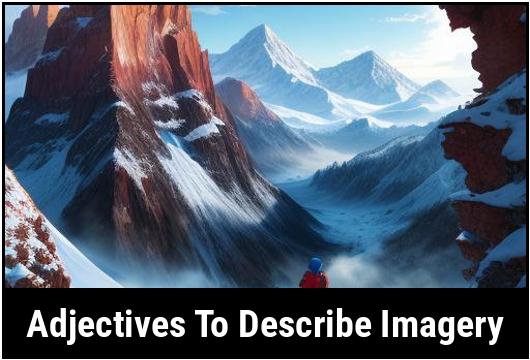- You are here:
- Home »
- adjectives
- » Adjectives To Describe Imagery

Adjectives To Describe Imagery
Imagery plays a significant role in evoking emotions, setting a scene, and creating powerful mental pictures in the minds of the readers. Adjectives serve as a vital tool in adding depth and nuance to these visual descriptions. By employing the right adjectives, writers can enhance the impact of their imagery. This article delves into the importance of using adjectives to describe imagery, the process of selecting the appropriate adjectives, and the various types of adjectives that can be employed to effectively convey vivid imagery.
Key Takeaways
- Adjectives play a crucial role in vividly describing imagery.
- The appropriate selection of adjectives can enhance the impact of imagery.
- Understanding the types and nuances of adjectives is essential for effectively describing imagery.
Adjectives To Describe Imagery
Adventurous
Imagine embarking on a thrilling journey where the scenery constantly changes – that is what adventurous imagery does. It evokes a sense of excitement, taking the reader through unexplored landscapes and unpredictable events. Think of vivid imagery that transports your readers to uncharted territories, filling them with a sense of thrill and wonder.
Blissful
Blissful imagery presents scenes of pure happiness and contentment. It captures moments of joy and peace, where everything seems perfectly in place. Use this adjective to paint a picture of serenity and tranquility, transporting your readers to a world of blissful harmony.
Captivating
Captivating imagery commands attention and holds readers spellbound. It creates a magnetic pull, drawing them into the scene and captivating their senses. With captivating imagery, you can weave a tale that enthralls and leaves your readers craving for more.
Dark
Dark imagery is often associated with mystery, fear, or foreboding. It sets a somber tone, casting shadows that hint at hidden secrets or impending danger. Use this adjective to create an atmosphere of uncertainty and intrigue in your writing.
Enchanting
Enchanting imagery is enticing and magical. It evokes a sense of wonder and captivates the reader’s imagination. Transport your audience to a world filled with ethereal beauty and captivating charm, where dreams come true and the impossible becomes possible.
Fragrant
Fragrant imagery stimulates the olfactory senses, conjuring up scents and aromas that enrich the reader’s experience. It allows them to immerse themselves in the story, taking in the delightful or pungent smells that surround the characters or setting.
Grand
Grand imagery creates a sense of awe and vastness. It showcases breathtaking landscapes, monumental architecture, or majestic phenomena that dwarf the human presence. Use this adjective to describe scenes of epic proportions, leaving your readers in awe of the magnificence depicted in your writing.
Harmonious
Harmonious imagery presents scenes where everything fits together in perfect harmony. It portrays a sense of balance, whether in nature or in human relationships. Use this adjective to describe moments when elements seamlessly combine, creating a symphony of beauty and tranquility.
Illuminating
Illuminating imagery sheds light on a scene, revealing details that would have otherwise gone unnoticed. It offers clarity and insight, illuminating the hidden aspects of a character or setting. Through illuminating imagery, you can provide your readers with a fresh perspective and a deeper understanding.
Joyful
Joyful imagery portrays scenes filled with happiness, laughter, and jubilation. It evokes a sense of cheerfulness and uplifts the reader’s spirits. Use this adjective to create imagery that radiates positivity, infusing your writing with boundless joy.
Kinetic
Kinetic imagery captures movement and energy in its purest form. It conveys a sense of action, whether it be a bustling city street or the graceful flight of a bird. Kinetic imagery brings your writing to life, making it dynamic and engaging.
Lush
Lush imagery portrays scenes characterized by richness and abundance. It showcases vibrant colors, lush vegetation, and a sense of opulence. Use this adjective to transport your reader to a world of luxury and lavishness, where they can indulge their senses.
Magical
Magical imagery sparks the reader’s imagination, conjuring up scenes that defy logic and reality. It transports them to a realm where extraordinary events occur and enchantment is a daily occurrence. Use this adjective to create a sense of wonder and enchantment in your writing.
Nostalgic
Nostalgic imagery evokes feelings of longing for the past. It paints a picture of sentimental moments and cherished memories. Use this adjective to transport your readers back in time, indulging them in a wave of bittersweet emotions.
Opulent
Opulent imagery is associated with extravagance and luxury. It portrays scenes of splendor and magnificence, indulging the senses with its grandeur. Use this adjective to transport your readers to a world of riches and affluence.
Playful
Playful imagery adds a touch of whimsy and fun to your writing. It paints scenes of carefree joy and light-heartedness, allowing your readers to embrace their inner child. Use this adjective to infuse your writing with a sense of playfulness and delight.
Quaint
Quaint imagery invites readers into scenes that are charmingly old-fashioned or picturesque. It has a nostalgic quality, transporting them to places where time seems to stand still. Use this adjective to add a touch of vintage allure to your writing.
Radiant
Radiant imagery captures scenes overflowing with brightness and light. It portrays a sense of luminosity that dazzles the reader’s senses. Use this adjective to create imagery that is vibrant and full of life, illuminating your writing like a sunbeam.
Serene
Serene imagery evokes a sense of calm and tranquility. It depicts scenes of stillness and peacefulness, where the world seems to pause. Use this adjective to transport your readers to a world of serenity, allowing them to breathe in the tranquility.
Thrilling
Thrilling imagery sparks excitement and anticipation in the reader. It takes them on a rollercoaster ride of emotions, leaving them on the edge of their seat. Use this adjective to create imagery that is suspenseful and keeps your readers hooked.
Vibrant
Vibrant imagery bursts with life and energy. It depicts scenes filled with vivid colors and vivaciousness. Use this adjective to transport your readers to a world that pulsates with vitality and dynamism.
Whimsical
Whimsical imagery is imaginative and fantastical. It conjures up scenes that seem to defy the laws of logic and reality, reminiscent of dreams and fairy tales. Use this adjective to add an element of enchantment and wonder to your writing.
Xanthic
Xanthic imagery is associated with the color yellow and everything connected to it. It depicts bright and sunny scenes, brimming with warmth and radiance. Use this adjective to create imagery that is cheerful and uplifting, like a golden ray of sunshine.
Yearning
Yearning imagery evokes deep emotions of desire and longing. It captures scenes where unrequited love or unfulfilled dreams are a prevalent theme. Use this adjective to create imagery that tugs at the heartstrings, igniting a sense of intense longing and yearning in your readers.
Zealous
Zealous imagery radiates fervor and passion. It depicts scenes where emotions run high, be it love, anger, or determination. Use this adjective to create imagery that is intense and emotive, stirring the reader’s soul.
Why Use Adjectives To Describe Imagery
Adjectives are essential in describing imagery because they add depth, detail, and texture to the scenes and visuals portrayed in literary works. When used effectively, adjectives can elevate the impact of imagery by making it more evocative and sensory. They create a more immersive experience for the reader by painting a detailed mental picture and appealing to the reader’s emotions and senses.
In addition to enhancing the sensory experience, adjectives also help in precision and specificity. They enable the writer to convey exactly what they envision, allowing for a more accurate and nuanced portrayal of the imagery. Whether it’s describing the shades of a sunset, the texture of a fabric, or the aroma of a blooming flower, adjectives are indispensable in capturing the intricacies of visual and sensory experiences.
Moreover, adjectives assist in setting the tone and mood of a narrative. By carefully selecting adjectives, writers can create an atmosphere that aligns with the emotions and ambiance they aim to convey. Whether it’s a scene laden with foreboding darkness or a lively and vibrant landscape, adjectives play a pivotal role in shaping the overall mood and tone of a literary work.
How To Choose The Right Adjective To Describe Imagery
Selecting the right adjectives to describe imagery requires a thoughtful and deliberate approach. Writers must consider the specific details they aim to emphasize and the overall effect they want to achieve. Here are some key considerations to keep in mind when choosing adjectives for imagery:
Consider The Five Senses
When describing imagery, it’s essential to consider how the scene appeals to the five senses – sight, sound, touch, taste, and smell. By consciously incorporating adjectives that evoke each of these senses, writers can create a more comprehensive and immersive portrayal of the imagery. For instance, in describing a bustling marketplace, adjectives like "fragrant," "deafening," and "pulsating" can be used to convey the various sensory elements at play.
Emphasize Specificity
Specificity is crucial in choosing adjectives for imagery. Instead of using generic adjectives, opt for more precise and detailed descriptors that create a vivid and clear mental picture. For example, instead of simply stating "a beautiful garden," consider adjectives such as "lush," "radiant," or "serene" to paint a more vivid and specific image in the reader’s mind.
Align With The Mood And Tone
Adjectives should align with the overall mood and tone of the narrative. If the scene is intended to be ominous and unsettling, adjectives like "haunting," "gloomy," or "eerie" would be more appropriate. On the other hand, for a cheerful and uplifting setting, adjectives such as "joyful," "vibrant," or "effervescent" would better convey the desired mood.
Avoid Overuse And Clichés
While adjectives are essential for describing imagery, it’s important to strike a balance and avoid overusing them. Overloading descriptions with multiple adjectives can dilute their impact and make the writing feel exaggerated or tiresome. Additionally, clichéd adjectives can detract from the originality and authenticity of the imagery. Strive to use adjectives that are fresh, evocative, and apt for the specific imagery being portrayed.
Types Of Adjectives For Describing Imagery
Adjectives come in various types, each serving a distinct purpose in describing imagery. Understanding these types can empower writers to effectively convey the nuances of visual and sensory experiences. The following are some key types of adjectives used for describing imagery, along with examples of their application:
Descriptive Adjectives
Descriptive adjectives are used to provide specific details and characteristics about a subject. They are instrumental in vividly portraying imagery by offering detailed visual and sensory attributes. These adjectives serve to enhance the reader’s understanding and visualization of the scene. Examples of descriptive adjectives include:
- The sky was ablaze with a breathtaking array of vibrant colors during the sunset.
- She ran her fingers over the coarse, weathered surface of the ancient stone wall.
Emotive Adjectives
Emotive adjectives are employed to evoke specific emotions or feelings associated with the depicted imagery. They add a layer of depth and sentiment to the descriptions, allowing the reader to connect with the portrayed scenes on an emotional level. Emotive adjectives can significantly impact the mood and atmosphere of the narrative. Examples of emotive adjectives include:
- The haunting melody of the violin resonated through the desolate, moonlit streets.
- A sense of tranquil serenity enveloped the secluded, verdant meadow.
Spatial Adjectives
Spatial adjectives are utilized to convey the spatial relationships and dimensions of the depicted imagery. They are particularly effective in providing a sense of scale, perspective, and orientation within the described scenes. Spatial adjectives contribute to the reader’s spatial visualization of the depicted settings. Examples of spatial adjectives include:
- The expansive, azure ocean stretched infinitely to the horizon, merging seamlessly with the cerulean sky.
- A solitary, towering oak tree cast a sprawling, dappled shadow across the emerald expanse of the meadow.
Sensory Adjectives
Sensory adjectives are employed to evoke the five senses and convey the sensory experiences associated with the depicted imagery. They capture the sights, sounds, textures, tastes, and aromas within the described scenes, creating a multi-dimensional and immersive portrayal. Sensory adjectives are integral in engaging the reader’s sensory perception. Examples of sensory adjectives include:
- The pungent aroma of freshly brewed coffee wafted through the cozy, sunlit café.
- Her fingertips traced the velvety, delicate petals of the crimson rose, reveling in their silken softness.
Color Adjectives
Color adjectives are specifically focused on describing the varied hues and shades within the depicted imagery. They play a crucial role in conveying the visual palette and adding vibrancy and richness to the described scenes. Color adjectives are effective in creating vivid visual impressions and emphasizing the aesthetic appeal of the imagery. Examples of color adjectives include:
- The sapphire waters of the tranquil lagoon shimmered in the golden hues of the setting sun.
- Clusters of vibrant, crimson poppies adorned the lush, verdant meadows in a striking display of natural beauty.
Qualitative Adjectives
Qualitative adjectives are employed to denote the qualities and attributes inherent to the depicted imagery. They serve to characterize and define the nature of the portrayed subjects, contributing to a more nuanced and insightful depiction. Qualitative adjectives are valuable in shaping the reader’s perception and understanding of the imagery. Examples of qualitative adjectives include:
- The ancient, mystical forest exuded an aura of enigmatic tranquility and profound wisdom.
- The tumultuous, relentless waves crashed against the rugged, imposing cliffs with awe-inspiring force.
By leveraging the power of adjectives, writers can imbue their imagery with richness, depth, and nuance. Adjectives serve as the palette with which the vivid tapestry of imagery is painted, facilitating a more immersive and evocative reading experience. Additionally, understanding the various types of adjectives and their applications enables writers to craft imagery that is not only visually striking but also emotionally resonant and sensorially engaging. Through careful consideration and deliberate selection, adjectives can elevate the impact of imagery, leaving a lasting impression on the minds of the readers.
Examples Of Adjectives For Different Types Of Imagery
When it comes to describing imagery, the right choice of adjectives can make all the difference. Adjectives are words that enhance and add depth to our descriptions, allowing readers to vividly visualize and connect with the scene being described.
-
Visual Imagery:
- Vivid: The sunset painted the sky in vivid hues of pink and orange.
- Luminous: The moon cast a luminous glow over the sleeping city.
- Vibrant: The garden was adorned with vibrant flowers of every color.
- Serene: The tranquil lake reflected the serene beauty of the surrounding mountains.
- Scenic: The winding road offered scenic views of the picturesque countryside.
-
Auditory Imagery:
- Thunderous: The thunderous applause filled the concert hall.
- Melodic: The vocalist’s voice was melodic and soothing to the ears.
- Resonant: The sound of the church bells echoed with a resonant tone.
- Piercing: The screeching of the brakes pierced through the silence of the night.
- Rhythmic: The drumbeat created a rhythmic pattern that energized the crowd.
-
Olfactory Imagery:
- Fragrant: The garden was filled with the fragrant scent of blooming roses.
- Aromatic: The kitchen was filled with the aromatic smells of freshly brewed coffee.
- Pungent: The pungent smell of onions made tears well up in her eyes.
- Sweet: The bakery was filled with the sweet aroma of freshly baked bread.
- Musky: The musky scent of the cologne lingered in the air long after he had left.
-
Gustatory Imagery:
- Salty: The sea breeze carried a subtle salty taste on her lips.
- Tangy: The tangy orange juice left a zesty sensation on his tongue.
- Bitter: The bitter taste of disappointment lingered in his mouth.
- Sweet: The chocolate melted in her mouth, leaving behind a sweet sensation.
- Savory: The aroma of the sizzling steak filled the room with a savory flavor.
-
Tactile Imagery:
- Rough: His hands were calloused and rough from years of hard labor.
- Soft: The plush carpet felt soft and luxurious under her bare feet.
- Prickly: The thorny bushes brushed against his skin, leaving a prickly sensation.
- Smooth: The cool marble countertop felt smooth to the touch.
- Coarse: The sandpaper had a coarse texture that scratched against his fingertips.
These adjectives serve as a starting point and can be adapted to fit different contexts and writing styles. Experimenting with various adjectives can help create more engaging and descriptive imagery.
Common Mistakes In Using Adjectives To Describe Imagery
While using adjectives to describe imagery can greatly enhance the reader’s experience, there are some common mistakes that writers should be aware of to avoid weakening their descriptions:
- Overusing adjectives: Using too many adjectives in a sentence can clutter the text and make it sound forced. It’s important to use adjectives sparingly and choose the most impactful ones.
Incorrect: The large, white, fluffy clouds floated lazily in the bright blue sky filled with golden sunshine.
Correct: The fluffy clouds floated lazily in the bright blue sky filled with golden sunshine.
- Using generic adjectives: Generic adjectives like "nice," "beautiful," or "good" lack specificity and fail to paint a clear picture for the reader. Instead, opt for more precise and evocative adjectives.
Incorrect: The nice painting depicted a beautiful landscape.
Correct: The exquisite painting depicted a breathtaking landscape.
- Neglecting sensory details: Imagery is all about engaging the reader’s senses. It’s crucial to include sensory details that appeal to sight, sound, smell, taste, and touch to create a more immersive experience.
Incorrect: The garden was beautiful.
Correct: The garden was filled with vibrant colors and fragrant flowers.
- Failing to consider context: Adjectives should be chosen with the context in mind. Different adjectives may be more suitable for certain situations or settings. Consider the mood, tone, and overall atmosphere of the scene being described.
Incorrect: The sun was shining brightly on the gloomy day.
Correct: The sun cut through the thick clouds, casting a warm glow on the otherwise gloomy day.
By avoiding these common mistakes, writers can effectively use adjectives to create vivid and captivating imagery in their writing.
Using Adjectives Effectively
- Choose specific adjectives: Specific adjectives help paint a more detailed and vivid picture in the reader’s mind. Instead of using generic adjectives, opt for words that are more distinct and precise.
Incorrect: The delicious food
Correct: The mouthwatering cuisine
- Vary the use of adjectives: To keep the writing engaging, it’s essential to vary the use of adjectives. Instead of using the same adjectives repeatedly, experiment with synonyms or explore alternative descriptions.
Incorrect: The tall, tall trees reached toward the sky.
Correct: The towering trees reached toward the sky.
- Prioritize concrete language: Concrete language helps readers visualize and connect with the imagery. Use words that appeal to the senses and provide tangible descriptions.
Incorrect: She wore a nice dress.
Correct: She wore an elegant, flowing dress that shimmered in the moonlight.
- Be aware of connotations: Adjectives can have different connotations. Consider the emotional impact and associations that certain adjectives may carry. Use adjectives that align with the desired mood and tone of the scene.
Incorrect: The small house
Correct: The cozy cottage
-
Read your writing aloud: Reading your writing aloud can help identify any awkward or clunky descriptions. Pay attention to the flow and rhythm of the sentences and ensure that the adjectives enhance the overall imagery.
-
Edit and revise: The choice of adjectives can greatly impact the quality of the imagery. Take the time to edit and revise your writing to ensure that the adjectives used effectively enhance the descriptions.
Exercises And Practice
To improve your ability to describe imagery using adjectives, here are a few exercises and practice techniques:
-
Visualize and describe: Choose a simple object or scene and close your eyes. Visualize the object or scene in your mind and try to describe it using as many adjectives as possible. Focus on appealing to all the senses and creating a vivid mental picture.
-
Descriptive word bank: Create a word bank of descriptive adjectives. Start with general categories like colors, textures, and emotions, and then brainstorm specific adjectives within each category. Refer to this word bank when writing to help you choose more precise and evocative adjectives.
-
Rewrite sentences: Take a simple sentence and rewrite it using more descriptive adjectives. Practice incorporating sensory details and experiment with different adjectives to enhance the imagery.
-
Feedback and critique: Share your writing with others and ask for their feedback. Consider their suggestions and critiques regarding the use of adjectives in your descriptions. This can help you identify areas for improvement and expand your vocabulary.
-
Read and analyze: Read books, poems, and articles known for their exemplary use of descriptive language. Pay attention to how adjectives are used to create vivid imagery and stimulate the reader’s senses. Analyzing and studying the works of skilled writers can inspire and inform your own descriptive writing.
Conclusion
Adjectives play a vital role in describing imagery and creating a vivid and engaging reading experience. By choosing specific and evocative adjectives, writers can paint a clear and detailed picture in the reader’s mind. It’s important to avoid common mistakes, such as overusing adjectives or using generic ones, and to prioritize sensory details to make the descriptions more immersive. By practicing and refining the use of adjectives, writers can master the art of descriptive imagery and captivate their readers with their vivid and engaging prose.
FAQS On Adjectives To Describe Imagery
What Is Imagery?
Imagery refers to the use of descriptive language to create a vivid mental picture or sensory experience for the reader.
Why Are Adjectives Important In Describing Imagery?
Adjectives are important because they add detail and specificity to the imagery, making it more impactful and engaging for the reader.
What Are Some Common Adjectives Used To Describe Imagery?
Some common adjectives used to describe imagery include colorful, vivid, captivating, evocative, and descriptive.
How Can Adjectives Be Used Effectively To Enhance Imagery?
Adjectives can be used effectively by choosing specific and sensory-driven words, avoiding overused or vague adjectives, and incorporating figurative language such as similes and metaphors.
In What Genres Of Writing Is Imagery Commonly Utilized?
Imagery is commonly used in poetry, fiction, and creative non-fiction, but can also be effective in other genres such as persuasive writing, speeches, and advertising.








